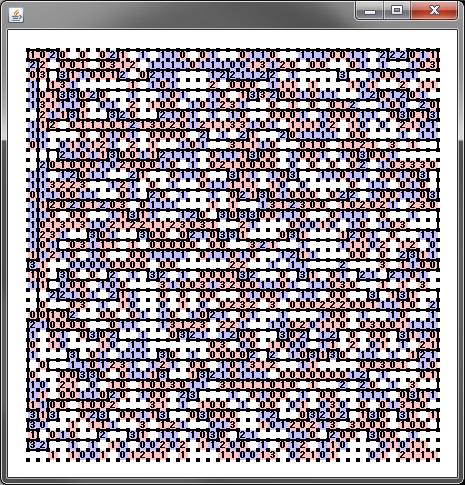方針とか
最初に書いたコードは、「ランダムに長方形をプロットして、一番ましなやつを出力」でした。
主な目的は出力形式の確認ですかね……。
二番目に書いた(そして最終である)コードは、盤面をジグザグに辿りながら、2 と 3 の横を通るときに適当に曲がって充足させるものです。
画像で見た方が早いと思うので以下を参照。
では、以下汚いコードの品評会です。
コード
typedef vector<int> VI; typedef vector<VI> VVI; typedef vector<string> VS; typedef pair<int,int> PII; typedef istringstream ISS; #define REP( i, m, n ) for ( int i = (int)( m ); i < (int)( n ); ++i ) #define ALL( c ) (c).begin(), (c).end() #define MP( a, b ) make_pair( ( a ), ( b ) ) #define fst first #define snd second const char dirchar[] = "DURL"; map<char,PII> dir; class FixTheFence { public: int sz; VS board; string findLoop( vector<string> board ) { sz = board.size(); this -> board = board; dir['D'] = MP( 1, 0 ); dir['U'] = MP( -1, 0 ); dir['R'] = MP( 0, 1 ); dir['L'] = MP( 0, -1 ); vector< VS > guides( sz + 1, VS( sz + 1 ) ); REP( i, 0, sz + 1 ) { fill( ALL( guides[i] ), i % 4 < 2 ? 'R' : 'L' ); guides[i][0] = 'U'; guides[i][1] = 'U'; } for ( int i = 0; i < sz; i += 2 ) { REP( j, 2, sz ) { switch ( i % 4 ) { case 0: switch ( board[i][j] ) { case '2': guides[i][j] = "RDR"; guides[ i + 1 ][j] = "RUR"; break; case '3': guides[i][j] = "DRUR"; guides[ i + 1 ][j] = "URDR"; guides[i][ j + 1 ] = "DR"; guides[ i + 1 ][ j + 1 ] = "UR"; break; } break; case 2: switch ( board[i][j] ) { case '2': guides[i][ j + 1 ] = "LDL"; guides[ i + 1 ][ j + 1 ] = "LUL"; break; case '3': guides[i][ j + 1 ] = "DLUL"; guides[ i + 1 ][ j + 1 ] = "ULDL"; if ( guides[i][j] == "L" ) { guides[i][j] = "DL"; guides[ i + 1 ][j] = "UL"; } break; } break; } } } REP( i, 0, sz ) { switch ( board[i][0] ) { case '2': guides[ i + 1 ][0] = "URU"; guides[ i + 1 ][1] = "ULU"; break; case '3': guides[ i + 1 ][0] = "RULU"; guides[ i + 1 ][1] = "LURU"; guides[i][0] = "RU"; guides[i][1] = "LU"; } } int y = 0, x = 2; string res( "0 0 RR" ); while ( y + 4 <= sz ) { while ( true ) { PII d = diffCoordinate( guides[y][x] ); int dy = y + d.fst, dx = x + d.snd; if ( inside( dy, dx ) ) { res += guides[y][x]; y = dy; x = dx; } else { break; } } while ( y % 4 != 2 ) { y++; res += 'D'; } while ( true ) { PII d = diffCoordinate( guides[y][x] ); int dy = y + d.fst, dx = x + d.snd; if ( inside( dy, dx ) ) { res += guides[y][x]; y = dy; x = dx; } else { break; } } while ( y % 4 ) { y++; res += 'D'; } } res += string( x - 1, 'L' ); x = 1; while ( true ) { PII d = diffCoordinate( guides[y][x] ); int dy = y + d.fst, dx = x + d.snd; if ( 0 <= dy && dy < sz + 1 && 0 <= x && x < sz + 1 ) { res += guides[y][x]; y = dy; x = dx; } else { break; } } res += string( y, 'U' ); if ( x ) { res[2] = '1'; res.erase( 5, 1 ); } return res; } PII diffCoordinate( string guide ) { int y = 0, x = 0; REP( i, 0, guide.size() ) { PII d = dir[ guide[i] ]; y += d.fst; x += d.snd; } return MP( y, x ); } bool inside( int y, int x ) { return 0 <= y && y < sz + 1 && 2 <= x && x < sz + 1; } void dumpResult( string str ) { int y, x; string walk; ISS( str ) >> y >> x >> walk; VVI visited( sz + 1, VI( sz + 1, 0 ) ); REP( i, 0, walk.size() ) { visited[y][x] ++; PII d = dir[ walk[i] ]; y += d.fst; x += d.snd; } REP( i, 0, visited.size() ) { REP( j, 0, visited[i].size() ) { if ( 2 <= visited[i][j] ) { cout << "visited twice at ( " << i << ", " << j << " ) ." << endl; } } } return; } };
